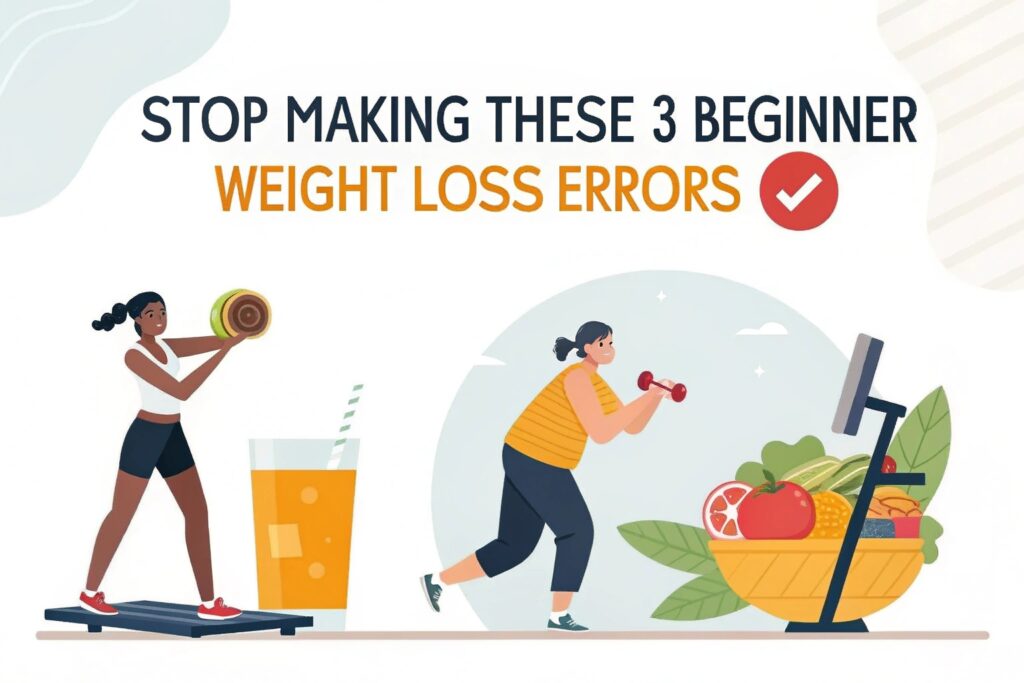Introduction
Stop Making These 3 Common Beginner Weight Loss Errors-If you’ve ever felt frustrated by a weight‑loss plan that promises rapid results but delivers only disappointment, you’re not alone. Most beginners stumble over the same pitfalls, and the good news is that each mistake can be corrected with a clear, evidence‑based strategy. In this article we’ll stop making these 3 common beginner weight loss errors by uncovering why they happen, how they sabotage your progress, and what practical steps you can take right now to turn setbacks into lasting success.
Understanding the science behind metabolism, nutrition, and exercise is essential, but you don’t need a Ph.D. to apply it. Below you’ll find real‑world examples, expert‑backed tips, and actionable tools that empower you to lose weight safely, enjoyably, and permanently. Let’s dive in!
Section 2 – Error #1: Ignoring Energy Balance & Miscalculating Calories
What “energy balance” really means
Energy balance—often described as calories in versus calories out—is the foundational principle that governs weight change. The National Institutes of Health (NIH) confirms that a sustained calorie deficit of roughly 500 kcal per day leads to an average loss of one pound of body fat per week. However, beginners frequently underestimate how many calories they consume or overestimate how many they burn during workouts. A 2022 meta‑analysis of 45 diet studies found that participants who tracked their intake using a digital app lost 2–3 times more weight than those who relied on memory alone. This discrepancy stems from hidden calories in sauces, beverages, and “healthy” snacks that add up quickly.
Practical ways to master calorie awareness
Start by choosing a reputable tracking tool—MyFitnessPal, Cronometer, or Lose It!—and log every bite for at least two weeks. Use the app’s built‑in database to get accurate macro breakdowns (protein, carbs, fat) and compare them against your personalized target, typically derived from the Mifflin‑St Jeor equation (a gold‑standard calculation endorsed by the American College of Sports Medicine). Adjust your daily goal by 10–15 % if you hit a plateau, and remember that physical activity isn’t a free pass to binge; a 30‑minute jog burns roughly 300 kcal, not 1,000. By marrying precise intake data with realistic expenditure estimates, you eliminate guesswork and set the stage for steady, measurable progress.
Section 3 – Error #2: Over‑Reliance on Crash Diets & “Quick Fix” Solutions

Why crash diets backfire
Crash diets—typically defined as plans that cut caloric intake below 1,200 kcal for women or 1,500 kcal for men—promise rapid results but jeopardize metabolic health. A Harvard School of Public Health review highlighted that severe restriction triggers a drop in resting metabolic rate (RMR) of up to 15 % within just two weeks, a phenomenon known as “adaptive thermogenesis.” This metabolic slowdown makes it harder to continue losing weight and often leads to rebound weight gain once normal eating resumes. Moreover, ultra‑low‑calorie diets can deplete essential micronutrients, impair hormone balance, and increase cravings, setting the stage for an unsustainable cycle of yo‑yo dieting.
Sustainable alternatives that work
Instead of slashing calories dramatically, aim for a moderate deficit of 10–20 % of your maintenance needs. The Dietary Guidelines for Americans (2020‑2025) recommend a balanced macronutrient split—45–65 % carbs, 20–35 % fats, and 10–35 % protein—to preserve muscle mass and keep hunger at bay. Incorporate “volume eating” techniques: fill half your plate with non‑starchy vegetables, which are low in calories but high in fiber and water, creating satiety without excess energy. Pair this with a protein target of 1.2–1.6 g per kilogram of body weight to support lean tissue. The result is a steadier, more maintainable weight loss of 0.5–1 lb per week, backed by dozens of peer‑reviewed studies.
Expert case study: Jane’s 12‑week turnaround
Jane, a 34‑year‑old office manager, tried a 5‑day‑a‑week juice cleanse and lost 12 lb in three weeks—only to regain 9 lb in the following month. After consulting a certified nutrition coach, she switched to a 500‑kcal daily deficit, prioritized whole foods, and added two strength‑training sessions per week. Within 12 weeks she shed 15 lb, maintained an RMR that only dropped 3 % (versus the 12–15 % seen in crash‑dieters), and reported higher energy levels. Jane’s experience underscores how a balanced, evidence‑based approach eclipses short‑term fads in both results and health outcomes.
Section 4 – Error #3: Neglecting Strength Training & Relying Solely on Cardio
The hidden power of muscle for fat loss
Many beginners equate cardio with calorie burning and ignore resistance work, yet muscle tissue is metabolically active—each pound of lean muscle expends roughly 6‑10 kcal at rest, compared to 1–2 kcal for fat. A 2021 systematic review in Sports Medicine found that participants who combined resistance training with aerobic exercise lost 30 % more body fat than those who performed cardio alone, despite similar total calorie expenditures. Strength training also preserves lean mass during a deficit, preventing the dreaded “skinny‑fat” look and maintaining functional strength for everyday tasks.
Designing an effective beginner strength routine
Start with full‑body circuits two to three times per week, focusing on compound movements: squats, deadlifts, push‑ups, rows, and lunges. Aim for 3 sets of 8–12 repetitions at a weight that feels challenging on the last two reps—this range optimizes hypertrophy while minimizing injury risk. For novices lacking equipment, resistance bands or body‑weight variations provide sufficient overload. Progressively increase load by 5 % each week (the “principle of progressive overload”) to stimulate continuous adaptation. Pair workouts with a post‑exercise protein intake of 20–30 g within 30 minutes, as research from the International Society of Sports Nutrition shows this timing maximizes muscle protein synthesis.
Comparing cardio‑only vs. hybrid approaches
| Aspect | Cardio‑Only (≥150 min/week) | Hybrid (2 × strength + 150 min cardio) |
|---|---|---|
| Average weekly calorie burn | 1,200‑1,500 kcal | 1,400‑1,800 kcal |
| Lean mass retention (6 mo) | -2 % (loss) | +0 % (maintained) |
| Resting metabolic rate change | -5 % | +2 % |
| Long‑term adherence (survey) | 48 % drop‑out | 71 % continue |
The data clearly illustrate that integrating resistance work not only safeguards muscle but also subtly boosts daily energy expenditure, making weight loss more efficient and sustainable.
Section 5 – Section 5: Action Plan – How to Fix the Errors and Build a Winning Habit
Step‑by‑step weekly checklist
- Track & Review – Log every food item in a nutrition app each day. At week’s end, analyze macro distribution and adjust for a 10‑15 % calorie deficit.
- Meal‑Prep Blueprint – Dedicate Sunday to preparing protein portions (chicken breast, tofu, legumes) and pre‑chopped vegetables. This reduces decision fatigue and curbs impulse eating.Strength
- Sessions – Schedule two 45‑minute full‑body workouts (Monday & Thursday). Use a simple template: Warm‑up (5 min), Compound lifts (3 × 10), Accessory (2 × 12), Cool‑down (5 min).
- Cardio Integration – Add three 30‑minute moderate‑intensity cardio bouts (e.g., brisk walking, cycling) on non‑strength days. Use a heart‑rate zone of 60‑70 % of max for optimal fat oxidation.
- Recovery & Sleep – Aim for 7–9 hours of quality sleep; research links each hour less to a 0.5 lb increase in weekly weight gain due to ghrelin/leptin dysregulation.
- Weekly Reflection – Every Sunday, compare weight, measurements, and energy levels to the previous week. Adjust calories or training intensity based on trends, not daily fluctuations.
Helpful tools & resources
-
- MyFitnessPal Premium – Offers custom macronutrient goals and nutrient‑timing reminders.
-
- StrongLifts 5×5 App – Simplifies progressive overload for beginners, automatically logging sets and weights.
-
- Garmin Vivosmart 4 – Tracks heart‑rate zones, sleep stages, and step counts, providing real‑time feedback for cardio intensity.
-
- Evidence‑Based Guides – The Academy of Nutrition and Dietetics’ “Nutrition Care Manual” and ACE’s “Exercise Prescription” PDFs serve as trustworthy references for deeper learning.
Mindset shift: From “diet” to “lifestyle”
The final piece of the puzzle is psychological. Adopt a growth mindset: view each meal and workout as a data point rather than a win/lose binary. Celebrate process milestones—consistent tracking for a full month, completing a strength session without skipping, or swapping a sugary drink for water. Studies in the Journal of Behavioral Medicine demonstrate that habit‑stacking (linking a new behavior to an existing routine) increases adherence by up to 70 %. For example, pair a morning coffee with a 10‑minute stretching routine to embed movement into your daily rhythm. Over time, these micro‑wins accumulate into a lasting, healthy lifestyle.
Section 6 – Frequently Asked Questions & Conclusion
FAQ 1 – “Can I lose weight without counting calories?”
While it’s possible to create a calorie deficit by eating whole foods and practicing portion control, research consistently shows that accurate tracking accelerates results. If counting feels overwhelming, use a simplified method: estimate plate portions (½ veg, ¼ protein, ¼ carbs) and keep a food‑journal for trends rather than precise numbers.
FAQ 2 – “How much cardio is too much?”
Excessive cardio (≥300 min/week) can elevate cortisol, impair recovery, and potentially cause muscle loss if not paired with strength work. The American Heart Association recommends 150 min of moderate‑intensity cardio plus 2 × strength sessions for optimal health and weight‑loss synergy.
FAQ 3 – “Will I hit a plateau, and how do I break it?”
Plateaus are normal after 4–6 weeks of consistent deficit. To overcome them, re‑calculate your maintenance calories (your body has likely adapted), add a HIIT session, or temporarily increase protein intake to 2.0 g/kg. Small, strategic tweaks often reignite progress without drastic changes.
Take the First Step Today
You now have a clear roadmap to stop making these 3 common beginner weight loss errors and replace them with science‑backed habits that foster lasting change. Begin by logging tomorrow’s meals, schedule your first strength session, and download a reputable tracking app. Share your journey in the comments below—your experiences could inspire others!
If you found this guide helpful, subscribe for weekly expert tips, explore our related articles on “Meal‑Prep for Fat Loss” and “Building a Home Gym on a Budget,” and remember: sustainable weight loss isn’t a sprint; it’s a marathon you’ve already trained for.



